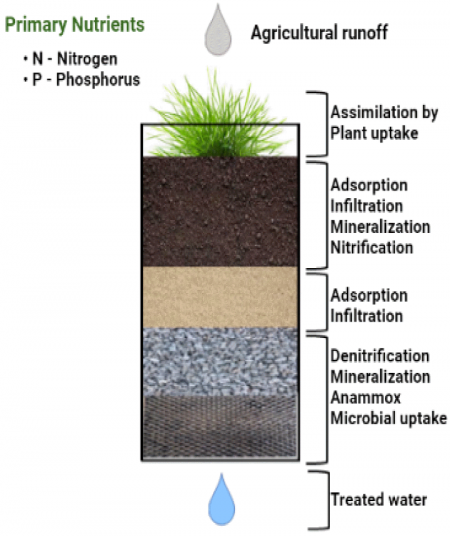Nutrients

Overview[edit]
Nutrients are an essential part of life, however excess amounts of them can harm the environment. Anthropogenic activities can lead to such excessive amount of nutrients in runoff and cause degradation of receiving waters. Phosphorus and Nitrogen are the main nutrients of concern in stormwater runoff. This page provides information on the sources of nutrients, the issues caused by their excess amounts, and strategies to manage them.
Nutrient pollution[edit]
The primary concern with excess amounts of nutrients is eutrophication (U.S. EPA 1999[2]). Eutrophication is the process of excessive algae growth due to abundance of nutrients that can cause hypoxic condition in water. Excessive algal growth can cover the surface of water and prevent light penetration. Without light, the desirable aquatic plants die off. The eventual decay of aquatic plants and algae, consumes the dissolved oxygen in the water and creates hypoxic condition that can kill fish and other aquatic animals.
Nutrient pollution has been noted as a critical environmental, public health, and economic concern in Canada, Great Lakes, Lake Winnipeg, Lac St. Charles, Lake Simcoe and other water bodies (CWN, 2017[3]). Nutrient pollution can cause environmental imbalance, pose a public health risk for drinking water (USEPA, 2009[4]) and swimming, as inhalation of algae by swimmers or pet can cause hypoxic condition. It can also affect the economy by harming fisheries, tourism, recreation, and increase the treatment cost of drinking water. Historical algal bloom in the Lake Erie during 1960s caused a substantial decline of native aquatic species (CWN, 2017[3]). In 2015 more than 5,000 km2 of Lake Erie was covered by algal blooms rendering the water unsuitable for drinking for residents of Pelee Island, Ontario and Toledo, Ohio (CWN, 2017[3]). In 2011 and 2014, severe nutrient pollution in this lake caused service interruption, equal to $71 million and $65 million USD (Bingham, Sinha, & Lupi, 2015[5]). Reports of nutrient pollution are increasing across Canada causing more beach closures and decline in water quality and fisheries (CWN, 2017[3]).
References[edit]
- ↑ Osman, M., Takaijudin, H., Massoudieh, A. and H.W., Goh. 2022. Effects of Vegetation and Saturated Zone in Cascaded Bioretention on Enhancing Nutrient Removal. Environmental Engineering Research, 28(3), p.220154.
- ↑ U.S. Environmental Protection Agency (EPA). (1999). Preliminary data summary of urban storm water best management practices. Pub. No. EPA-821-R-99-012, Washington, DC.
- ↑ 3.0 3.1 3.2 3.3 CWN (Canadian Water Network). (2017). Nutrient Management—Research Insights for Decision Makers. CWN Report, November, 26.
- ↑ United States Environmental Protection Agency (USEPA), 2009. Managing Stormwater Runoff to Prevent Contamination of Drinking Water. Source Water Protection Practices Bulletin. United States Environmental Protection Agency, Office of Water, Washington, D.C.
- ↑ Bingham, M., Sinha, S. K., & Lupi, F. (2015). Economic benefits of reducing harmful algal blooms in Lake Erie. Retrieved from International Joint Commission website: http://ijc.org/fi les/tinymce/uploaded/Publications/Economic-Benefits-Due-to-Reduction-in-HABs-October-2015.pdf